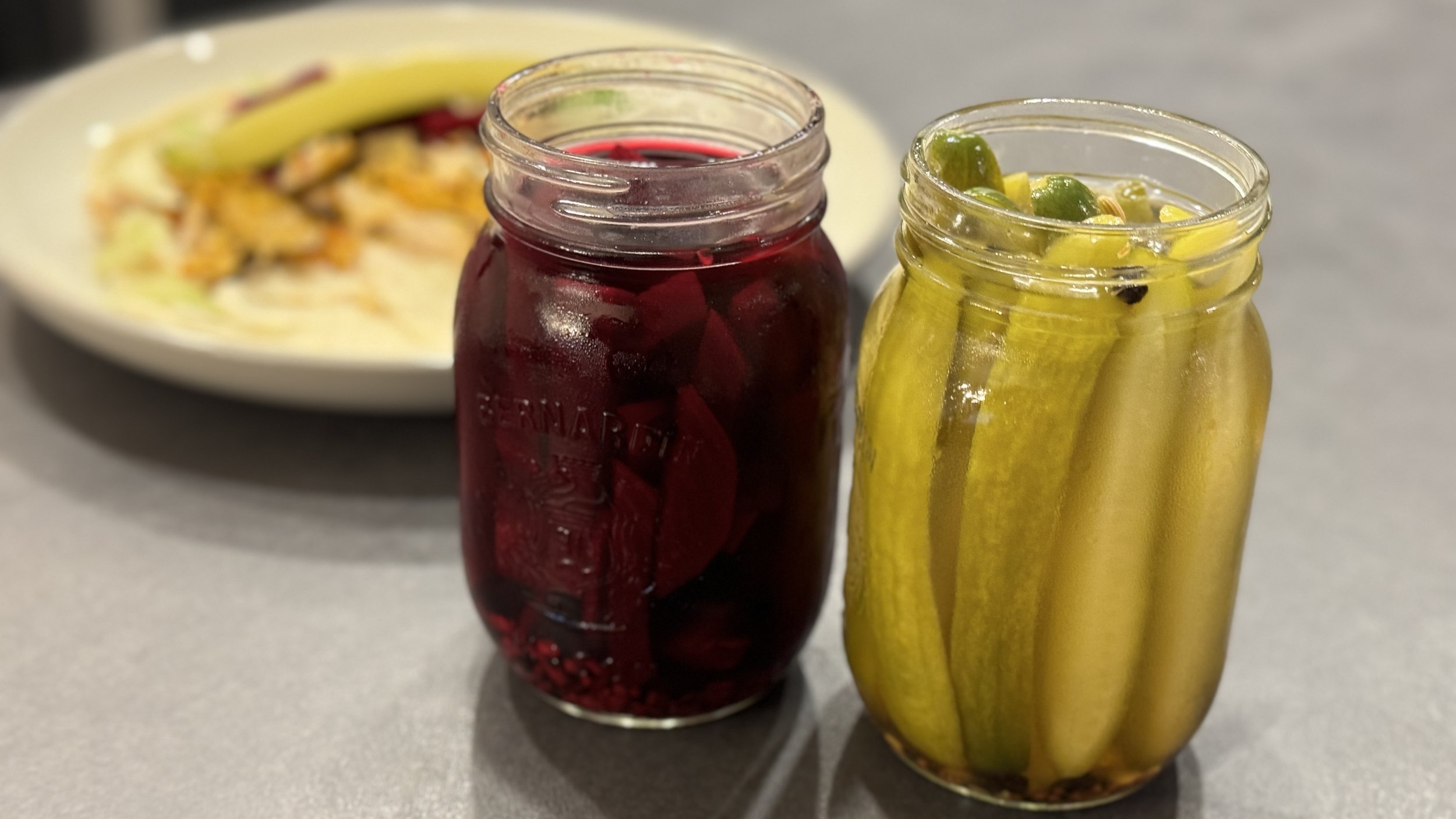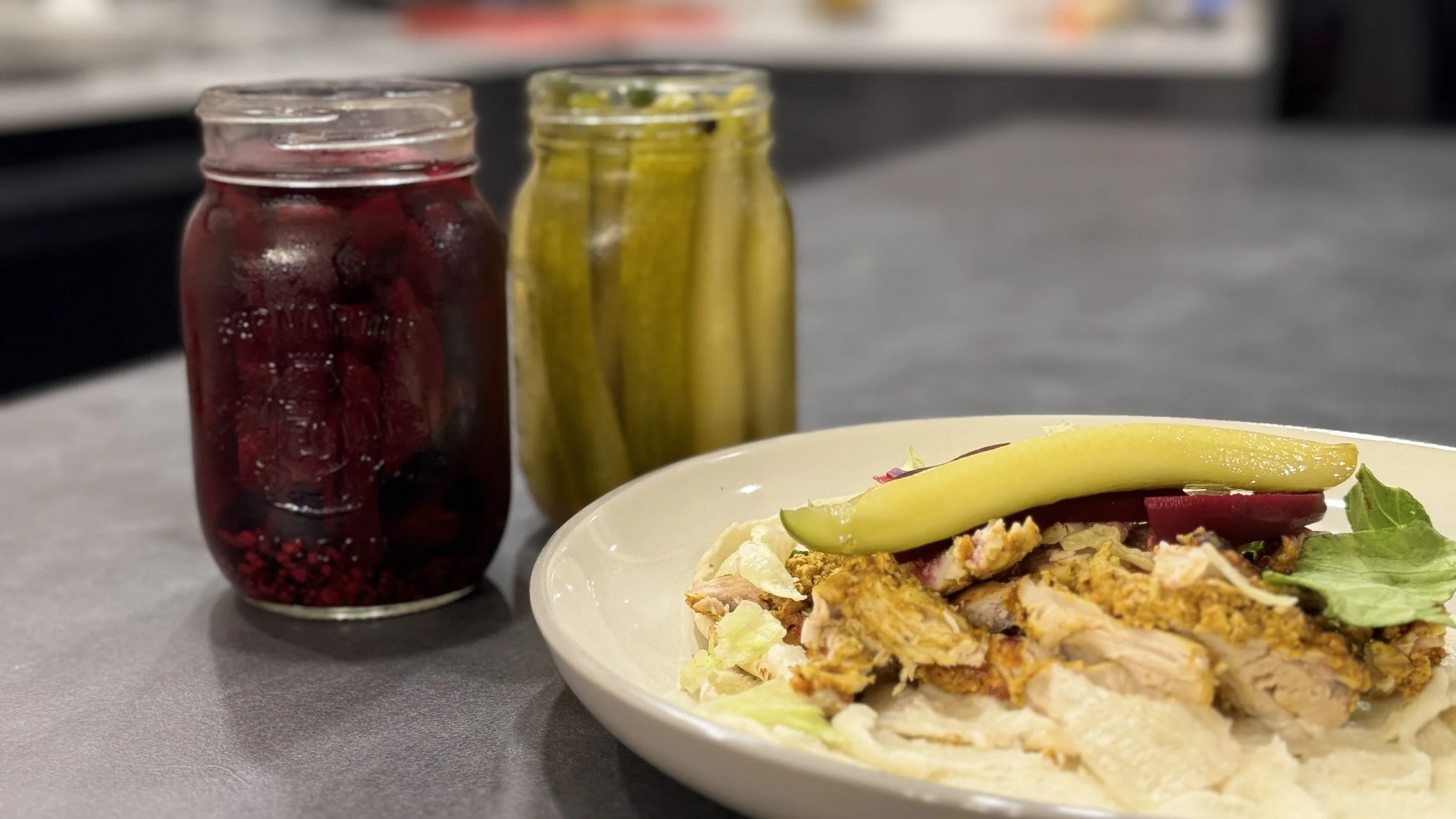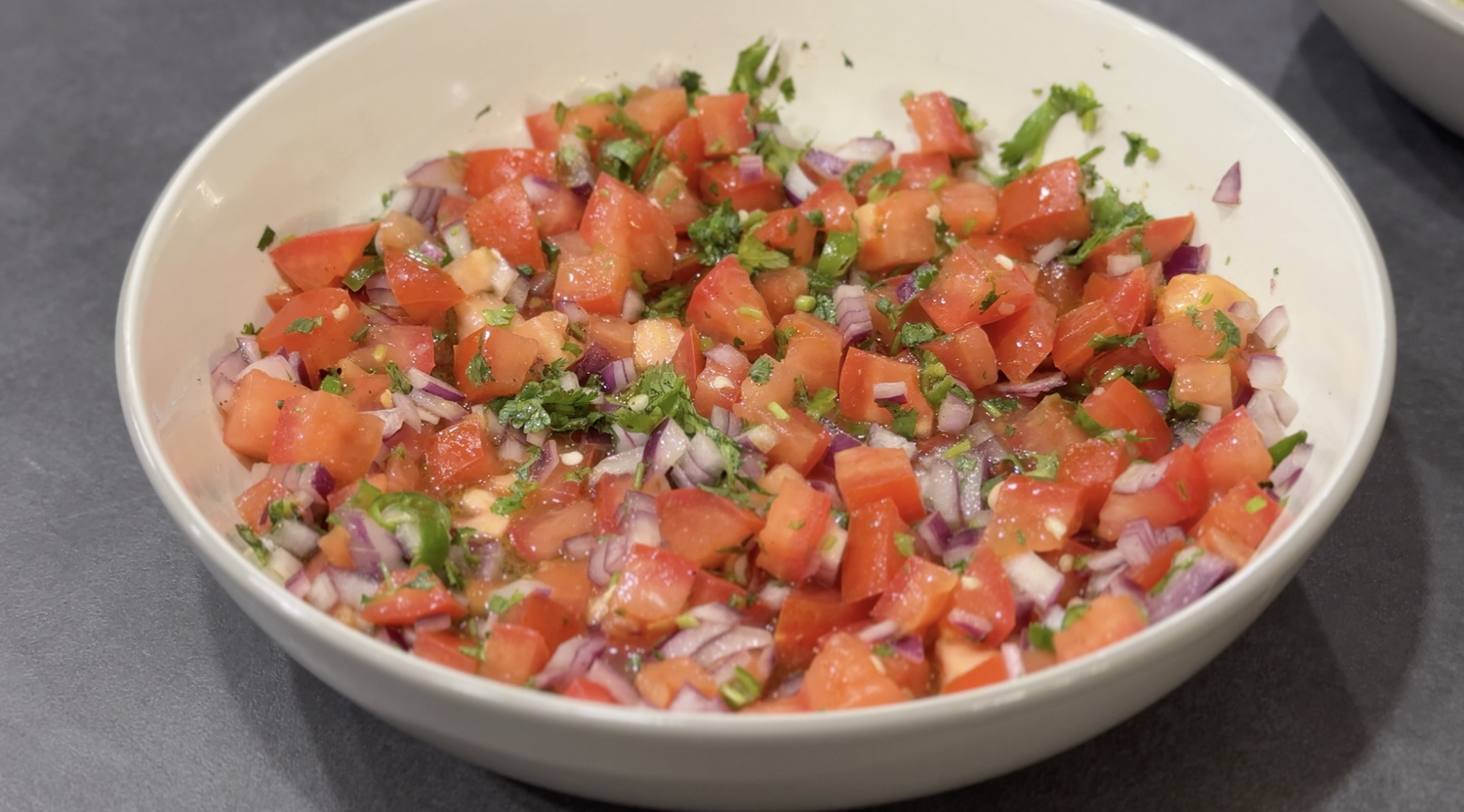How to Make Easy Pickled Vegetables
This post may contain affiliate links. Read our disclosure policy
This guide on How to Make Easy Pickled Vegetables will show you how to make delicious pickled vegetables in just a matter of minutes with only a few ingredients! While this demonstration on the best pickled vegetables uses cucumbers and beets, you can use a variety of vegetables with this simple formula!
Want to switch up your regular vegetables? Pickling them will be such a game changer, and I guarantee after you do it once, you’ll want to do it again and again! As I mention in my free motivational guide to explore your potential in the kitchen, Making Cooking Fun!!, if you’re not sure what to cook, then use what you already have for inspiration. To really extend the lifespan of your vegetables and to add a new punch of flavour to your typical sandwiches and wraps, then you need to get pickling today!
I’ve had phases where I’ve made lots of pickled vegetables and other phases where I forget about it. However, I’m glad to be back in it, as I realize how delicious and nutritious pickled vegetables are!
To get the full visual representation on how to perfectly pickle your vegetables, in addition to all of my tips and tricks to make the best pickled vegetables ever, be sure to watch the video at the bottom of this post! If you’re not already, please subscribe to my YouTube channel, and be sure to press the bell button so you’re notified when all of my video recipes are live! Let’s get pickling!
Why You’ll Love Pickled Vegetables!
Vegetable preservation: Worried about your vegetables going bad? Pickling your vegetables allows them to stay good for a very long time so you don’t have to worry about them spoiling!
Versatile: Check out lots of options to use your pickled vegetables later on in this post! Plus, you can pickle pretty much any vegetable of your choice!
Tasty: I just love the flavour of pickled vegetables, it’s just so satisfying! This should be a reason alone to go pickle your vegetables today!
Excellent for digestion: Fermented foods really assist in digestion because of their high concentration in probiotics. You’re better off pickling your own vegetables so that you can control the amount of salt! High-sodium packaged pickled foods can cause their own set of issues if you’re not mindful of the quantities, but to be safe, homemade is always best!
A very special gift: Want to give something handmade from the heart? Pickled vegetables can be a very unique and heartwarming gift, so if you need some creative gift ideas, I would put your heart in a jar by following this Pickled Vegetables recipe as part of your Live to Cook one-month challenge!
Dietary friendly: These delicious Pickled Vegetables have no barrier to entry! They’re gluten-free, vegetarian, vegan, fat-free, gluten-free, and low in sugar and salt.
Equipment needed for Easy Pickled Vegetables
Ingredients for Pickled Vegetables
You can refer to the FULL PRINTABLE RECIPE CARD for all ingredients and their quantities and to save the recipe for later by scrolling to the bottom of this post or by pressing the “Jump to Recipe” button. The recipe card also allows you to scale the recipe so that you have the right amount of sugar and vinegar based on how many veggies you want to pickle!
Pickling Solution
Vegetables: To demonstrate in this recipe, I’m using cucumbers and beetroot. I’ll be using these later on in my Homemade Chicken Shawarma recipe!
Rice vinegar: This is the main pickling agent. I recommend you go for the unseasoned rice vinegar so you have more control over the sugar and salt here. If by mistake you do have seasoned rice vinegar, I recommend you reduce the sugar and salt by half, as seasoned rice vinegar already has both of those.
Sugar: I go with regular white table sugar for sweetness here, but cane sugar could also work if you want a more natural option. Sugar is key to balance out the strength of the vinegar.
Water: Needed to blanch the beetroot, and you’ll want a little bit in order to dilute the vinegar.
Salt: You always need salt to bring out the flavours!
For Flavouring
Whole spices: This is optional but adds lots of aroma to your pickled veggies! For this pickling solution, I’ll be adding cumin seeds, fenugreek seeds, fennel seeds, brown mustard seeds, nigella seeds (this combination is actually known as Panch Phoran, or Indian Five-Spice) and black peppercorn.
How to Make Quick Pickled Veggies
Prepare the pickling solution
In a saucepan, combine the water, vinegar, sugar and salt.
Whisk well to dissolve the sugar and salt. Then, bring this mixture to a boil.
Once boiling, turn off the heat and set it aside.
To make the pickled vegetables
To prepare the veggies, begin by cutting the baby cucumbers into quarters lengthwise.
Wash, scrub and peel the beets and then slice into 1/2 inch strips.
Blanch the beets to soften them slightly by boiling a pot of water and cooking the beets for 2-3 minutes.
Transfer to an ice water bath and then drain after 3-5 minutes.
Place the veggies into separate mason jars and divide the whole spices between each of the jars.
Fill the jars with the pickling solution, making sure to fill the jar to cover the veggies entirely. Allow the pickled veggies to cool to room temperature before sealing the jars and refrigerating. Allow to refrigerate for 24 hours for best results.
Enjoy!
Tips for the Best Pickled Vegetables!
For “harder” vegetables (such as beets, turnips, carrots or cauliflower), be sure to blanch them for a prior to pickling.
Allow the vegetables in the pickling solution to cool down to room temperature before shaking and storing.
Make sure that the pickling solution covers the vegetables ENTIRELY! Any gap between the vegetables and the jar that isn’t submerged in the pickling solution can lead to mold. You’ll have the optimal lifetime of your pickled vegetables by fully covering them in solution!
Since these pickles vegetables are homemade, you can easily control the amounts of sugar and salt based on your dietary preferences along with selecting the type of vinegar.
Traditionally, in the Middle East, white vinegar is used for preparing the pickled vegetables. Rice vinegar on the other hand is an Asian choice. You can use whichever vinegar you feel like or that you have on hand to prepare your pickled vegetables! More details in the next section.
I don’t Have Rice Vinegar! Can I use Other Types of Vinegar?
Yes, you sure can! I really love how rice vinegar adds a mellow, sweet flavour to the pickled vegetables, but if you to be traditional to Middle Eastern preparation methods, then go ahead and use white vinegar. Spices and herbs can really make the difference! Additionally, there’s nothing stopping you from experimenting with apple cider vinegar, or red wine vinegar.
Other Vegetables THat You Can Pickle
Onions
Radishes
Daikon
Peppers
Cauliflower
Carrots (either baby carrots or you can peel long strips of full-sized carrots)
Green beans
Turnips
Cabbage
Asparagus
Zucchini
You can even pickle fruits, including grapes, mangoes or amlas, which are Indian gooseberries, as you can see in my Amla Chutney recipe!
Other flavourings
These Pickled Vegetables are the basics to make them extremely versatile! However, you can customize this base recipe based on what type of flavours you are looking for. Here’s what you can do to enhance your pickled vegetables:
Heat: Add in some jalapeños or other types of chilli peppers.
Herbs: You can add fresh herbs including basil, cilantro, dill, rosemary, thyme, sage, bay leaves, scallions, parsley, dill or oregano.
Aromatics: Freshly peeled ginger, turmeric root, or whole garlic cloves.
Whole spices: Other options from the ones I’ve shown above include coriander seeds, star anise, cloves, or allspice.
How do You Use Pickled Vegetables?
You can use your Pickled Vegetables over a variety of sandwiches and wraps or burgers! Here are some ideas:
Don’t stop there! Pickled Veggies can also accompany:
Hot dogs or on top of sausages, such as Argentinian Choripan.
How to Store Pickled Vegetables
The best way to store pickled veggies is in a mason jar, but if you really don’t have that, then an airtight container will work fine if you’ve made a really big batch of pickled veggies. Be sure to keep your pickled vegetables in the fridge!
How Long Do Pickled Vegetables Last?
Since these pickled vegetables are not fermented or canned, their shelf life is much shorter, namely between 2-4 weeks given proper preparation and storage method used to refrigerate them. Always ensure to use an air tight jar and check for any spoilage before enjoying.
Other Fresh Veggie Recipes
WATCH HOW TO MAKE Easy Pickled Vegetables HERE:
Let me know what you think of this recipe in the comments! If you’ve tried this recipe, be sure to post it on social media and tag it with #cookingwithanadi and mention me @cooking.with.anadi. Thank you!

How to Make Easy Pickled Vegetables
Ingredients
- 2 Cups water
- 2 Cups rice vinegar
- 2 Tbsp sugar
- 2 Tbsp salt
- 2-3 baby cucumbers, cut into quarters lengthwise
- 2-3 beetroot, washed, scrubbed and peeled
- 3 tsp cumin seeds
- 1 1/2 tsp fenugreek seeds
- 2 tsp fennel seeds
- 2 tsp brown mustard seeds
- 2 tsp nigella seeds
- 2 tsp black peppercorn
Instructions
- In a saucepan, combine the water, vinegar, sugar and salt.
- Whisk well to dissolve the sugar and salt. Then, bring this mixture to a boil.
- Once boiling, turn off the heat and set it aside.
- To prepare the veggies, begin by cutting the baby cucumbers into quarters lengthwise.
- Wash, scrub and peel the beets and then slice into 1/2 inch strips.
- Blanch the beets to soften them slightly by boiling a pot of water and cooking the beets for 2-3 minutes.
- Transfer to an ice water bath and then drain after 3-5 minutes.
- Place the veggies into separate mason jars and divide the whole spices between each of the jars.
- Fill the jars with the pickling solution, making sure to fill the jar to cover the veggies entirely. Allow the pickled veggies to cool to room temperature before sealing the jars and refrigerating. Allow to refrigerate for 24 hours for best results.
Nutrition Facts
Calories
249.85Fat (grams)
5.13 gSat. Fat (grams)
0.55 gCarbs (grams)
35.3 gFiber (grams)
8.15 gNet carbs
27.21 gSugar (grams)
24.47 gProtein (grams)
7.09 gSodium (milligrams)
7090.21 mgCholesterol (grams)
0 mgFollow me
Meet Anadi
Welcome to Cooking With Anadi. This platform is all about making cooking exciting and finding new ways to bring classic flavours and recipes at your service. Join me in my personal journey in the world of cooking. Hope you have a great ride!































































































